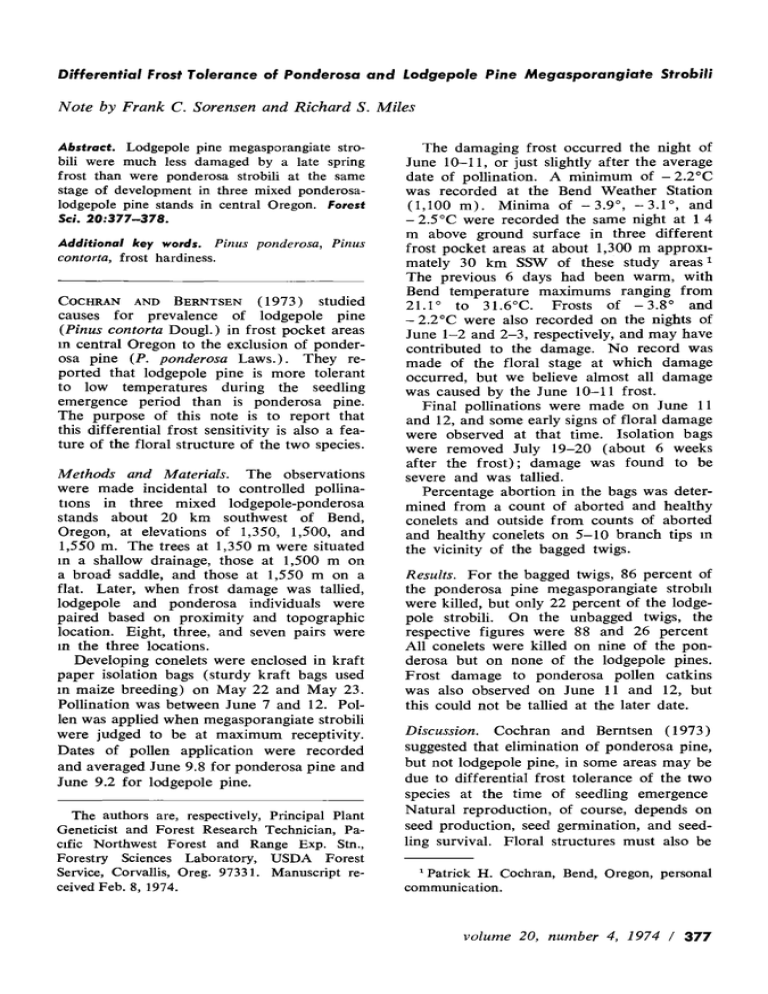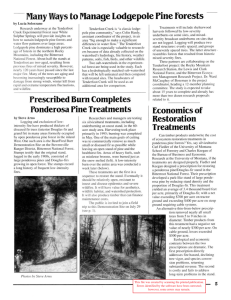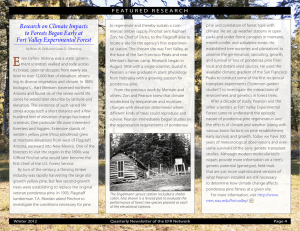Note Frank Sorensen and RichardS. Miles
advertisement

Differential Frost Tolerance of Ponderosa and Lodgepole Pine Megasporangiate Strobili Note by Frank C. Sorensen and RichardS. Miles Abstract. Lodgepole pine megasporangiate stro­ bili were much less damaged by a late spring frost than were ponderosa strobili at the same stage of development in three mixed ponderosa­ lodgepole pine stands in central Oregon. Forest Sci. 20:377-378. Additional key words. Pinus ponderosa, Pinus contorta, frost hardiness. COCHRAN AND BERNTSEN (1973) studied causes for prevalence of lodgepole pine (Pinus contorta Dougl.) in frost pocket areas m central Oregon to the exclusion of ponder­ osa pine (P. ponderosa Laws.). They re­ ported that lodgepole pine is more tolerant to low temperatures during the seedling emergence period than is ponderosa pine. The purpose of this note is to report that this differential frost sensitivity is also a fea­ ture of the floral structure of the two species. Methods and Materials. The observations were made incidental to controlled pollina­ tiOns in three mixed lodgepole-ponderosa stands about 20 km southwest of Bend, Oregon, at elevations of 1,350, 1,500, and 1,550 m. The trees at 1,350 m were situated m a shallow drainage, those at 1,500 m on a broad saddle, and those at 1,550 m on a flat. Later, when frost damage was tallied, lodgepole and ponderosa individuals were paired based on proximity and topographic location. Eight, three, and seven pairs were m the three locations. Developing conelets were enclosed in kraft paper isolation bags (sturdy kraft bags used m maize breeding) on May 22 and May 23. Pollination was between June 7 and 12. Pol­ len was applied when megasporangiate strobili were judged to be at maximum receptivity. Dates of pollen application were recorded and averaged June 9.8 for ponderosa pine and June 9.2 for lodgepole pine. The authors are, respectively, Principal Plant Geneticist and Forest Research Technician, Pa­ Cific Northwest Forest and Range Exp. Stn., Forestry Sciences Laboratory, USDA Forest Service, Corvallis, Oreg. 97331. Manuscript re­ ceived Feb. 8, 1974. The damaging frost occurred the night of June 10--11, or just slightly after the average date of pollination. A minimum of - 2.2°C was recorded at the Bend Weather Station (1,100 m). Minima of - 3.9°, -3.1 °, and - 2.5°C were recorded the same night at 1 4 m above ground surface in three different frost pocket areas at about 1,300 m approxi­ mately 30 km SSW of these study areas 1 The previous 6 days had been warm, with Bend temperature maximums ranging from 21.1° to 31.6°C. Frosts of - 3.8° and - 2.2°C were also recorded on the nights of June 1-2 and 2-3, respectively, and may have contributed to the damage. No record was made of the floral stage at which damage occurred, but we believe almost all damage was caused by the June 10-11 frost. Final pollinations were made on June 11 and 12, and some early signs of floral damage were observed at that time. Isolation bags were removed July 19-20 (about 6 weeks after the frost); damage was found to be severe and was tallied. Percentage abortion in the bags was deter­ mined from a count of aborted and healthy conelets and outside from counts of aborted and healthy conelets on 5-l 0 branch tips m the vicinity of the bagged twigs. Results. For the bagged twigs, 86 percent of the ponderosa pine megasporangiate strobili were killed, but only 22 percent of the lodge­ pole strobili. On the unbagged twigs, the respective figures were 88 and 26 percent All conelets were killed on nine of the pon­ derosa but on none of the lodgepole pines. Frost damage to ponderosa pollen catkins was also observed on June 11 and 12, but this could not be tallied at the later date. Discussion. Cochran and Berntsen (1973) suggested that elimination of ponderosa pine, but not lodgepole pine, in some areas may be due to differential frost tolerance of the two species at the time of seedling emergence Natural reproduction, of course, depends on seed production, seed germination, and seed­ ling survival. Floral structures must also be ' Patrick H. Cochran, Bend, Oregon, personal communication. volume 20, number 4, 1974 I 377 tolerant to environmental extremes. The pres­ ent observations indicate differential frost tolerance of the two species at still another phase in the regeneration cycle. The - 2.2°C on June 10-11 greatly differ­ entiated the two species. The probability of such a frost at the Bend Weather Station on or after this date is 0.32 (Climatological Handbook 1968). For a true expectation of floral damage, probability of a frost during sensitive stages in strobilus development and possible differences in specific flowering times from year to year would have to be taken mto account. Little information of this type ts available. However, where temperature seems to be such an important factor, it would be interesting to know whether these probabilities are related to stand composition. Finally, although various types of isolation bags have been observed to influence the en­ VIronment around the twig (Boyer and Woods 1973, Rohmeder and Eisenhut 1959) and to affect cone (Plym Forshell 1953) and seed stze (Sorensen 1973), there was no indication m this test that they affected the amount of frost damage. Literature Cited BoYER, W. D., and F. W. WooDs. 1973. Date of pollen shedding by longleaf pine advanced by increased temperatures at strobili. Forest Sci 19:315-318. CLIMATOLOGICAL HANDBOOK. 1968. Columbia Basin States, Temperature, Vol I, Part B, Table 1-19. CocHRAN, P. H., and C. M. BERNTSEN. 1973 Tolerance of lodgepole and ponderosa pine seedlings to low night temperatures. Forest Sci 19:272-280. PLYM FoRSHELL, C. 1953. The development of cones and seeds in the case of self- and cross-pollination in (Pinus silvestris L.). Medd Stat Skogsforskningsinst 43 ( 10): 1-42. (Swed. with Engl. summary.) RoHMEDER, E., and G. EisENHUT. 1959 Untersuchungen tiber das Mikroklima in Bestaubungsschutzbeuteln. Silvae Genet 8 · 1-13. SoRENSEN, F. C. 1973. Performance of wind­ pollination families and intra- and inter-stand crosses on contrasting forest soils. USDA Forest Serv Res Note 207, 7 p. Pac North­ west Forest & Range Exp Stn, Portland, Oreg Fornes annosus Proceedings of the Fourth International Conference on Fornes annosus. IUFRO Sec. 24: Forest Protection. Athens, Ga. Sept. 17-22, 1973. Printed by the Southeastern Forest Experiment Station, USDA Forest Service, Asheville, N.C. 1974. 289 p. Scientists from 14 countries met to discuss this world-wide root disease. Their deliberations are presented in 30 papers plus summary discussions of 7 main topics. 378 I Forest Science


